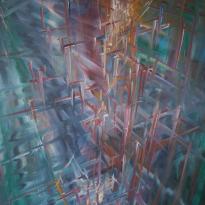Konrad Zuse - ZIB's Namesake
Konrad Zuse, born in Berlin in 1910, is the namesake of Zuse Institute Berlin (ZIB). After completing school he studied civil engineering and architecture at the predecessor of today’s Technical University Berlin. With the Z3, he developed the world’s first freely programmable computer. After World War II, he founded his own company, the Zuse KG. After he retired, he increasingly dedicated himself to his second passion: the art of painting. Konrad Zuse, who himself never acquired a doctoral degree, received numerous honorary doctoratesand awards. He died at the age of 85 in Hünfeld near Fulda. In 2010, on the occasion of his 100th anniversary, numerous events all over Germany was commemorate his work. Konrad Zuse, known today as the inventor of the world’s first freely programmable computer, is ZIB’s namesake.
Talent both in art and technics
Konrad Zuse was born in Berlin in 1910. He had a marked talent for both technics and art and made his first intelligent inventions in this childhood. For instance, he designed a road system for his visionary town of the future, inspired by the movie “Metropolis” (former ZIB logo). He experimented with an “automated photo laboratory” and a “money-changing vending machine”. In 1928, he graduated from high school and started studying mechanical engineering at the Polytechnical Institute of Berlin-Charlottenburg (predecessor of TU Berlin), but later switched to architecture andfinally civil engineering. This combination covered the two areas of interest that were of importance to him, thus enabling him to be engineer and artist at the same time.

The speech by Konrad Zuse (MP3) on the occasion of the foundation of ZIB on 22 November 1984.
Computer Construction at home
After completing his engineering studies, he worked as a structural engineer at Henschel aircraft factory in Berlin-Schönefeld, at the same time building his “inventor’s workshop” in his parents’ living room. He collected money from friends and family to be able to pay for tools and components. The result was the programmable digital computer Z1, completed in 1938 and completely mechanical at first, reading its commands from punched paper tapes. This was the first time that he used the binary number system in order to control programs. The engineer Zuse had an early understanding of the unity of arithmetic and logic operations. However, due to the insufficient accuracy of the mechanical components, the Z1 test model never functioned in practice.
In 1940, he received support from the Aerodynamische Versuchsanstalt (Aerodynamic Research Institute ) in Göttingen). He built the Z2, an improved version of the Z1 with telephone relays. In the same year, he founded the company “Zuse Apparatebau” (Zuse Apparatus Engineering) in order to produce programmable computers. In 1941, he developed the Z3 in a small apartment in Berlin-Kreuzberg. Today, the Z3 is regarded as the first functioning computer in the world. Between 1945 and 1947, Konrad Zuse also developed Plankalkül, the world’s first object-oriented programming language, which however, was not published until a couple of decades later.
Konrad Zuse as an entrepreneur
In 1945, the Z3 was destroyed by bombs. The Z4, which at that time had been partially completed, had been disassembled, packed and transported to a safe place Southern Germany, a small village in the Allgäu. There, he was visited by Swiss mathematicians Eduard Stiefel and Christian Rutishauser, who took a look at the computer that was standing in a barn. The Z4 was the only computer available in Europe. Konrad Zuse received 30,000 Swiss francs; the Z4 was completed and installed at the Swiss Institute of Technology Zurich. This was the first time that a computer brought economic success to its creator.
In 1949, Konrad Zuse founded the Zuse KG in Neukirchen. By 1967, the company had built a total of 251 computers. In 1964, Konrad Zuse left his company and was employed first by BBC Mannheim and later, at the beginning of 1967, by Siemens.
The artist Kuno See
After his retirement, he dedicated himself to his second great passion – the art of painting. Under the pseudonym “Kuno See“ he created abstract paintings and portraits of famous contemporaries. Today, two of his paintings are decorating the walls of ZIB. Konrad Zuse has received numerous awards and honors. For instance, he was awarded the Order of Merit of the Federal Republic of Germany, numerous honorary doctorates and two honorary professorships. He was still involved in the planning for the new building of Zuse Institute Berlin. One year after his death, the new building was inaugurated in Berlin-Dahlem.


Computer Museum
Are you interested in history, click here.
Sources
- Der Computer: Mein Lebenswerk
Konrad Zuse | Berlin 1984 - Die Ungnade der frühen Geburt
Wolfgang K. Giloi | Lecture | held on 12/12/1996 in memoriam Konrad Zuse - Konrad Zuse: Der Vater des Computers
Jürgen Alex, Hermann Flessner, Wilhelm Mons, Horst Zuse | Fulda 2000 - Die Rechenmaschinen von Konrad Zuse
Raul Rojas (Hrsg.) | Springer | Berlin 1998 - Der erste Computer. Konrad Zuses Z1 – Berlin 1936.
Beginn und Entwicklung einer technischen Revolution | Hadwig Dorsch | With contributions by Konrad Zuse and Otto Lührs. Museum für Verkehr und Technik | Berlin 1989 - „Ich bin zu faul zum Rechnen“
Konrad Zuses Computer Z22 im Zentrum für Kunst und Medientechnologie Karlsruhe | Clemens Kieser | In: Denkmalpflege in Baden-Württemberg, 4/34/2005 | Esslingen am Neckar | Page 180-184 - Was ist und wie verwirklicht sich Computer-Sozialismus
Gespräche mit Konrad Zuse | Arno Peters | Verlag Neues Leben | Berlin 2000 - Der Pionier des Computerbaus in Europa – Das verkannte Genie aus Adlershof.
Paul Janositz: Informatik und Konrad Zuse | In: Der Tagesspiegel Nr. 19127 | Berlin, March 9, 2006, Supplement | Page B3 - Die Frau, für die ich den Computer erfand.
Friedrich Christian Delius | Biographical novel | Rowohlt, Reinbek bei Hamburg 2009
